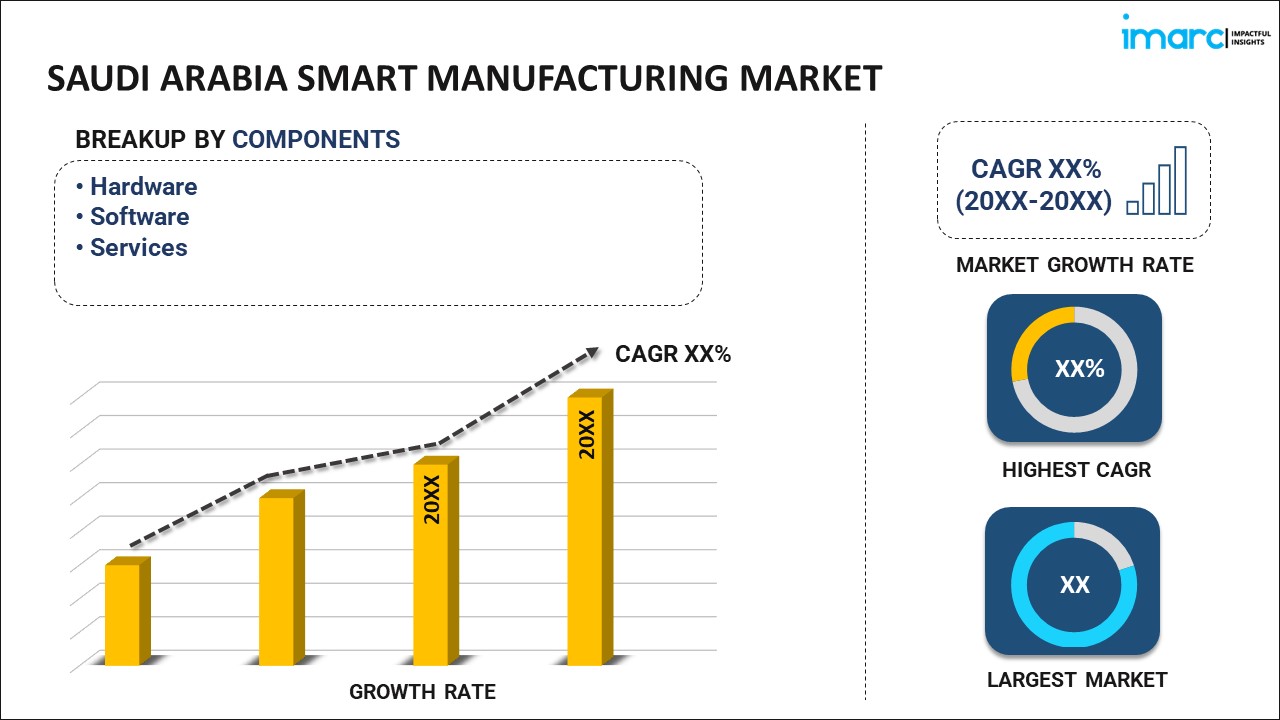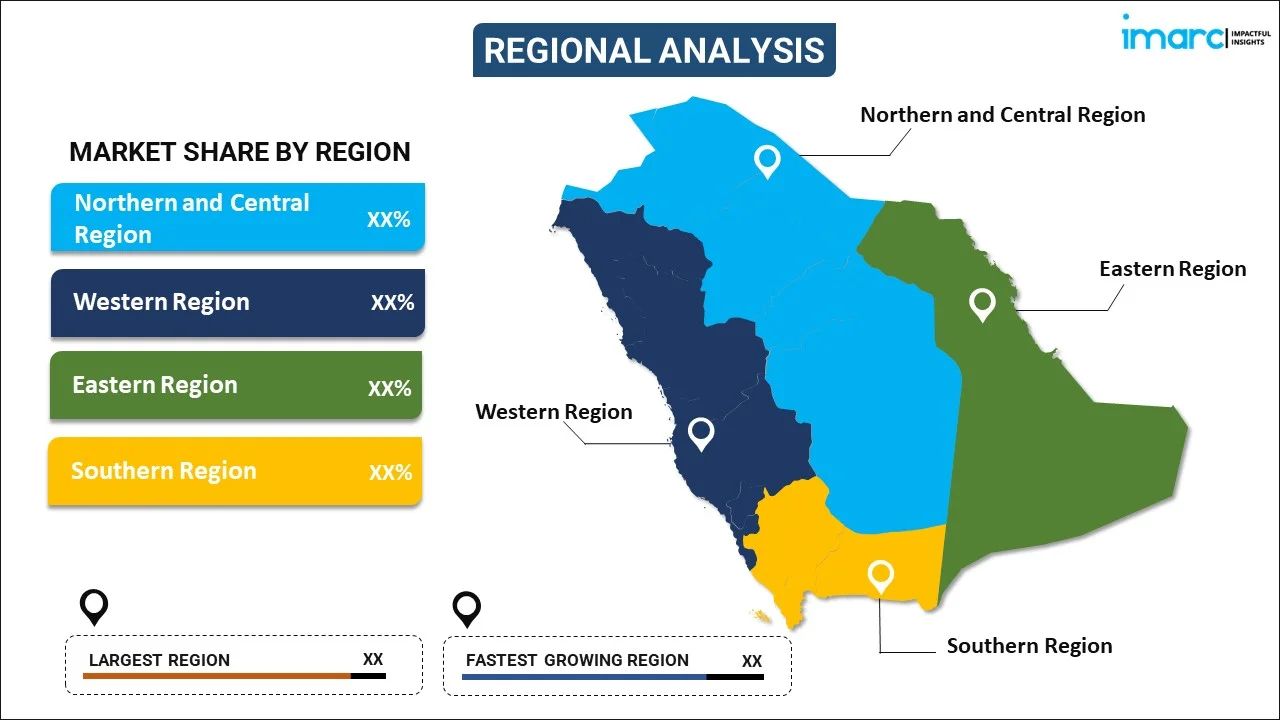
Saudi Arabia Smart Manufacturing Market Report by Component (Hardware, Software, Services), Technology (Machine Execution Systems, Programmable Logic Controller, Enterprise Resource Planning, SCADA, Discrete Control Systems, Human Machine Interface, Machine Vision, 3D Printing, Product Lifecycle Management, Plant Asset Management), End Use (Automotive, Aerospace and Defense, Chemicals and Materials, Healthcare, Industrial Equipment, Electronics, Food and Agriculture, Oil and Gas, and Others), and Region 2025-2033
Market Overview:
Saudi Arabia smart manufacturing market size reached USD 3,324.9 Million in 2024. Looking forward, IMARC Group expects the market to reach USD 10,974.7 Million by 2033, exhibiting a growth rate (CAGR) of 14.2% during 2025-2033. The increasing trend towards adopting smart manufacturing practices across the globe, the rising emphasis on industrial and manufacturing sector development, and the integration of 5G technology represent some of the key factors driving the market.
|
Report Attribute
|
Key Statistics
|
|---|---|
|
Base Year
|
2024
|
|
Forecast Years
|
2025-2033
|
|
Historical Years
|
2019-2024
|
| Market Size in 2024 | USD 3,324.9 Million |
| Market Forecast in 2033 | USD 10,974.7 Million |
| Market Growth Rate 2025-2033 | 14.2% |
Smart manufacturing represents a revolutionary approach in the industrial sector, integrating advanced technologies to create highly intelligent and automated production systems. This concept encompasses various types of technologies, such as Artificial Intelligence (AI), the Internet of Things (IoT), robotics, big data analytics, and cloud computing. These technologies enable real-time data analysis, predictive maintenance, and enhanced decision-making capabilities. Smart manufacturing systems offer a myriad of advantages, including improved efficiency, reduced operational costs, increased production quality, and enhanced flexibility in production processes. By leveraging these technologies, manufacturers can gain a significant competitive edge, fostering innovation and sustainability in their operations. The adaptability of smart manufacturing lies in its ability to cater to diverse industries, making it a versatile and transformative tool for the modern industrial landscape.
Saudi Arabia Smart Manufacturing Market Trends:
The market in Saudi Arabia is majorly driven by the growing trend towards adopting smart manufacturing practices. This can be supported by government initiatives aiming to diversify the economy and reduce dependence on oil. As part of this vision, there's a strong emphasis on industrial and manufacturing sector development, encouraging the adoption of smart technologies to enhance productivity and global competitiveness. Additionally, the increasing need for efficient resource management and the demand for high-quality products are propelling the adoption of smart manufacturing solutions in the region. The market is also witnessing a rise in investments in digital infrastructure, a critical enabler of smart manufacturing. This includes advancements in IoT, AI, and cloud computing, which are integral for real-time monitoring and automation of manufacturing processes. Along with this, the growing awareness among Saudi manufacturers about the long-term benefits of smart manufacturing, such as cost savings, improved safety, and reduced environmental impact, is significantly supporting the market. In addition, the integration of 5G technology is further accelerating the adoption of smart manufacturing, enhancing connectivity and data processing speeds. Moreover, the government's active support in the form of incentives, regulatory frameworks, and partnerships with technology providers is fostering a conducive environment for the growth of the market. Apart from this, the accelerating foreign direct investments and collaborations with global tech leaders are providing access to cutting-edge technologies and expertise, which is favoring the market. Furthermore, technological advancements, government initiatives, and an increasing emphasis on industrial modernization and efficiency are creating a positive market outlook. Some of the other factors driving the market include changing consumer preferences, rapid urbanization, and rising disposable income levels of individuals.
Saudi Arabia Smart Manufacturing Market Segmentation:
IMARC Group provides an analysis of the key trends in each segment of the market, along with forecasts at the country level for 2025-2033. Our report has categorized the market based on component, technology, and end use.
Component Insights:

- Hardware
- Software
- Services
The report has provided a detailed breakup and analysis of the market based on the component. This includes hardware, software, and services.
Technology Insights:
- Machine Execution Systems
- Programmable Logic Controller
- Enterprise Resource Planning
- SCADA
- Discrete Control Systems
- Human Machine Interface
- Machine Vision
- 3D Printing
- Product Lifecycle Management
- Plant Asset Management
A detailed breakup and analysis of the market based on the technology have also been provided in the report. This includes machine execution systems, programmable logic controller, enterprise resource planning, SCADA, discrete control systems, human machine interface, machine vision, 3D printing, product lifecycle management, and plant asset management.
End Use Insights:
- Automotive
- Aerospace and Defense
- Chemicals and Materials
- Healthcare
- Industrial Equipment
- Electronics
- Food and Agriculture
- Oil and Gas
- Others
The report has provided a detailed breakup and analysis of the market based on the end use. This includes automotive, aerospace and defense, chemicals and materials, healthcare, industrial equipment, electronics, food and agriculture, oil and gas, and others.
Regional Insights:

- Northern and Central Region
- Western Region
- Eastern Region
- Southern Region
The report has also provided a comprehensive analysis of all the major regional markets, which include Northern and Central Region, Western Region, Eastern Region, and Southern Region.
Competitive Landscape:
The market research report has also provided a comprehensive analysis of the competitive landscape in the market. Competitive analysis such as market structure, key player positioning, top winning strategies, competitive dashboard, and company evaluation quadrant has been covered in the report. Also, detailed profiles of all major companies have been provided.
Saudi Arabia Smart Manufacturing Market Report Coverage:
| Report Features | Details |
|---|---|
| Base Year of the Analysis | 2024 |
| Historical Period | 2019-2024 |
| Forecast Period | 2025-2033 |
| Units | Million USD |
| Scope of the Report | Exploration of Historical Trends and Market Outlook, Industry Catalysts and Challenges, Segment-Wise Historical and Future Market Assessment:
|
| Components Covered | Hardware, Software, Services |
| Technologies Covered | Machine Execution Systems, Programmable Logic Controller, Enterprise Resource Planning, SCADA, Discrete Control Systems, Human Machine Interface, Machine Vision, 3D Printing, Product Lifecycle Management, Plant Asset Management |
| End Uses Covered | Automotive, Aerospace and Defense, Chemicals and Materials, Healthcare, Industrial Equipment, Electronics, Food and Agriculture, Oil and Gas, Others |
| Regions Covered | Northern and Central Region, Western Region, Eastern Region, Southern Region |
| Customization Scope | 10% Free Customization |
| Post-Sale Analyst Support | 10-12 Weeks |
| Delivery Format | PDF and Excel through Email (We can also provide the editable version of the report in PPT/Word format on special request) |
Key Questions Answered in This Report:
- How has the Saudi Arabia smart manufacturing market performed so far and how will it perform in the coming years?
- What has been the impact of COVID-19 on the Saudi Arabia smart manufacturing market?
- What is the breakup of the Saudi Arabia smart manufacturing market on the basis of component?
- What is the breakup of the Saudi Arabia smart manufacturing market on the basis of technology?
- What is the breakup of the Saudi Arabia smart manufacturing market on the basis of end use?
- What are the various stages in the value chain of the Saudi Arabia smart manufacturing market?
- What are the key driving factors and challenges in the Saudi Arabia smart manufacturing?
- What is the structure of the Saudi Arabia smart manufacturing market and who are the key players?
- What is the degree of competition in the Saudi Arabia smart manufacturing market?
Key Benefits for Stakeholders:
- IMARC’s industry report offers a comprehensive quantitative analysis of various market segments, historical and current market trends, market forecasts, and dynamics of the Saudi Arabia smart manufacturing market from 2019-2033.
- The research report provides the latest information on the market drivers, challenges, and opportunities in the Saudi Arabia smart manufacturing market.
- Porter's five forces analysis assist stakeholders in assessing the impact of new entrants, competitive rivalry, supplier power, buyer power, and the threat of substitution. It helps stakeholders to analyze the level of competition within the Saudi Arabia smart manufacturing industry and its attractiveness.
- Competitive landscape allows stakeholders to understand their competitive environment and provides an insight into the current positions of key players in the market.
Need more help?
- Speak to our experienced analysts for insights on the current market scenarios.
- Include additional segments and countries to customize the report as per your requirement.
- Gain an unparalleled competitive advantage in your domain by understanding how to utilize the report and positively impacting your operations and revenue.
- For further assistance, please connect with our analysts.
 Inquire Before Buying
Inquire Before Buying
 Speak to an Analyst
Speak to an Analyst
 Request Brochure
Request Brochure
 Request Customization
Request Customization




.webp)




.webp)












